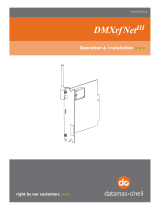
USING A WEB BROWSER........................................................................................................................ 4-1
Logging In ......................................................................................................................................... 4-1
Contacting Us .................................................................................................................................... 4-2
Configuring the Server Settings ........................................................................................................... 4-2
Configuring the Print Port Settings....................................................................................................... 4-3
Configuring Print Services................................................................................................................... 4-3
Setting Netware Parameters................................................................................................................ 4-4
Changing TCP/IP Settings................................................................................................................... 4-5
Configuring PrintraNet ........................................................................................................................ 4-6
Configuring Wireless Settings.............................................................................................................. 4-6
Configuring Alerts and Traps ............................................................................................................... 4-7
Receiving An Alert .......................................................................................................................... 4-8
SNMP IP Traps............................................................................................................................... 4-9
SNMP Netware Traps .....................................................................................................................4-10
Changing the Passwords....................................................................................................................4-11
Setting the Network Card Access Password......................................................................................4-11
Setting the Network Card Update Password......................................................................................4-12
Configuring Network Protocols............................................................................................................4-12
Controlling IP Access ........................................................................................................................4-13
To Add Hosts:................................................................................................................................4-13
To Remove Hosts...........................................................................................................................4-13
Configuring Network Security .............................................................................................................4-13
Printing a Test Page..........................................................................................................................4-14
Using the Console .............................................................................................................................4-14
Updating Firmware ............................................................................................................................4-14
To update from a TFTP server:........................................................................................................4-15
To update from a file on your computer: ...........................................................................................4-15
Loading the Firmware ........................................................................................................................4-15
Basic Security Configurations.............................................................................................................4-16
USING THE SIERRA SPORT CONFIGURATOR .......................................................................................... 5-1
System Requirements......................................................................................................................... 5-2
Before You Begin ............................................................................................................................... 5-2
Changing the Avalanche Directory ....................................................................................................... 5-2
Configuring Wireless Settings.............................................................................................................. 5-3
Configuring the Extended Security Settings .......................................................................................... 5-3
Configuring the Print Server Settings ................................................................................................... 5-3
Configuring Services .......................................................................................................................... 5-3
Configuring TCP/IP Settings................................................................................................................ 5-4
Specifying the IP Access Range .......................................................................................................... 5-4
Configuring Printranet Settings............................................................................................................ 5-4
Configuring NetWare Settings.............................................................................................................. 5-4
Setting Alerts and Traps ..................................................................................................................... 5-5
Configuring Printing Settings............................................................................................................... 5-5
Updating Files ................................................................................................................................... 5-6
Saving Changes ................................................................................................................................. 5-6
Creating Your Own Packages .............................................................................................................. 5-6
ii




















